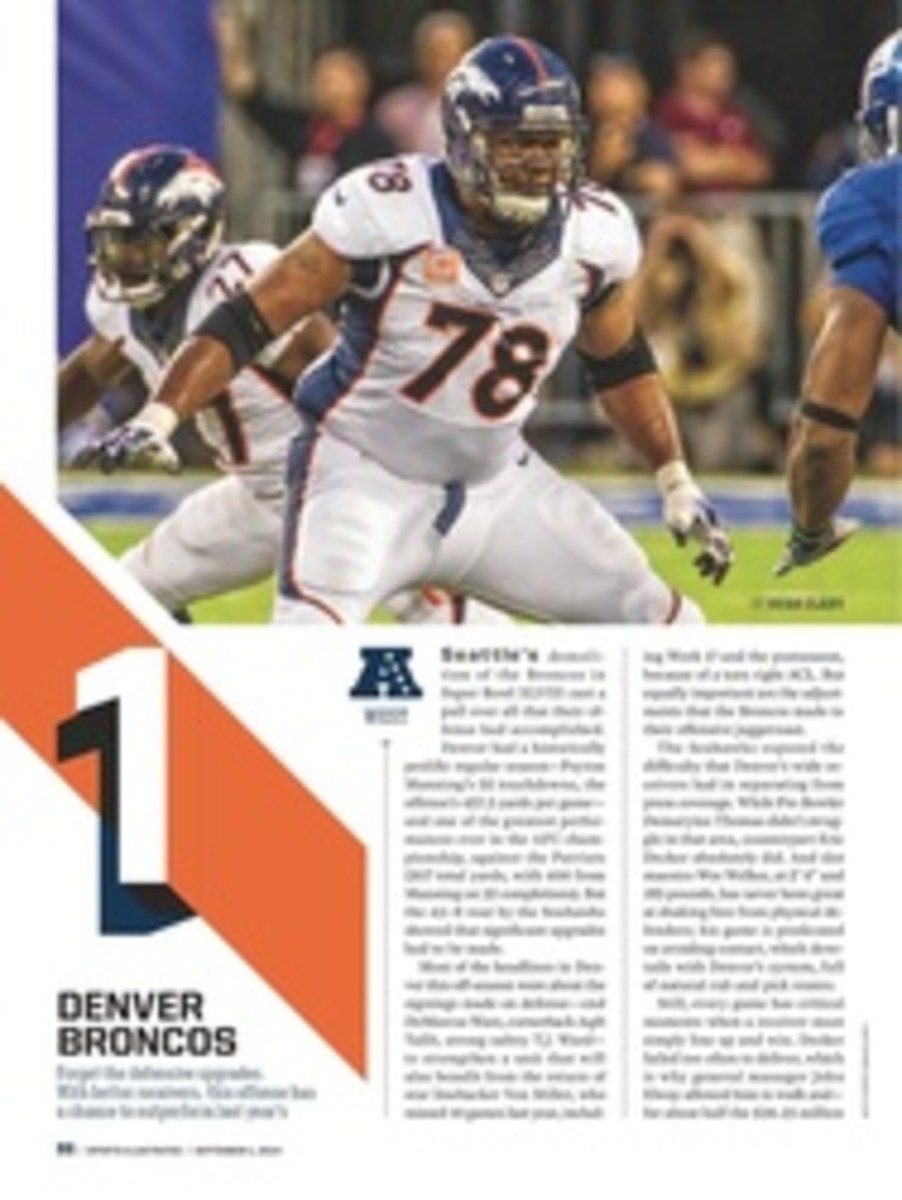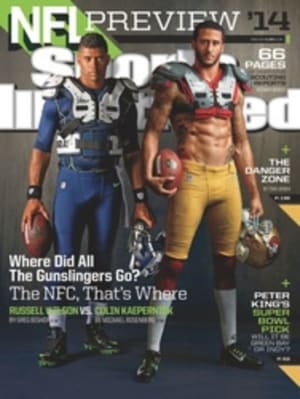
2 NEW YORK GIANTS
Defensive scheming, at its core, is just simple math. The objective is to disrupt the opposing quarterback with as few players as possible. In 2007 and '11 the Giants made successful Super Bowl runs as a good-but-not-great, low-seeded playoff team because they had a four-man pass rush that verged on being legendary.
Generating significant pressure with four linemen leaves a defense with seven players to cover five eligible receivers. To gain this same advantage, many D's have to operate out of amoeba 3--4 base schemes and use convoluted blitzes that confuse an offense's protections. It's a high-risk, high-reward approach—and one that those 4--3 Giants defenses were able to avoid, thanks to a bevy of dominant gap-shooting pass rushers. With the likes of Michael Strahan, Osi Umenyiora, Justin Tuck, Mathias Kiwanuka and, later, Jason Pierre-Paul working up front, the Giants could simply line up and attack the quarterback. Whatever gimmicks their defensive strategists did employ focused on the seven defenders left for coverage. That so-called NASCAR Front was so dominant, in fact, that those seven other defenders often had only four (and sometimes just three) potential receivers to worry about because of the extra bodies that offenses dedicated to help in pass protection.
But since the Giants' second Big Game ousting of New England, their front four has slowly and steadily declined. With Tuck's departure to Oakland in free agency (combined with Umenyiora's exit a year earlier and Strahan's retirement before that), Kiwanuka and Pierre-Paul are the only NASCAR Frontmen remaining, and neither was particularly impactful last season, when the Giants had one of the most anemic pass rushes in the league. With straight pass rushers, the difference between good and great is razor thin, and it carries enormous repercussions. A 10% drop in performance can be the difference between reaching the QB or not—and, for the purpose of this discussion, between drawing a double team or not.
Even if the freakishly gifted Pierre-Paul bounces back from the back and shoulder injuries that slowed him in 2013, and even if Kiwanuka flourishes despite being saddled with more snaps—depending on how last year's third-round pick, Damontre Moore, and free-agent pickup Robert Ayers do in filling Tuck's old role—New York's pass rush could still be iffy in '14.
With that in mind, GM Jerry Reese invested heavily in cornerbacks this off-season, signing Dominique Rodgers-Cromartie to a five-year, $35 million deal and slot connoisseur Walter Thurmond to a one-year, $3.5 million contract. Their arrival gives coordinator Perry Fewell—one of the best teachers and schemers in the business—the freedom to play more man coverage, and therefore to do more with blitzes. (Bringing five or six pass rushers forces a quarterback to get rid of the ball early, and playing man coverage is the best way to disrupt receivers immediately after the snap.) The idea of a straight four-man rush could be evanescing in New York.
Rodgers-Cromartie and Thurmond will join a secondary that has suffered copious injuries of late. When healthy, it's a better unit than most people think. Cornerback Prince Amukamara is learning to play with confidence and starting to show the ability that made him a first-round pick in 2011. Safety Antrel Rolle is versatile enough to drop into the slot, where he's an excellent run defender and a potentially dynamic blitzer. (He's also a very capable read-and-react player in space.) With the talented Will Hill gone—he was suspended for six games for violating the league's substance-abuse policy and then cut—Rolle will be joined in the middle backfield by Stevie Brown, who'll be coming off a torn left ACL and hoping to regain the opportunism that he showed as a surprise starter in 2012, when he had eight interceptions and two fumble recoveries, an NFL-high combination.
The hope: A sharp secondary and an adequate pass rush can compensate for a mediocre linebacking unit. Fortunately the offense should be able to hold its own. Despite preseason struggles, a new system implemented by first-time coordinator Ben McAdoo will ultimately reinvigorate quarterback Eli Manning and what has become an increasingly inconsistent supporting cast. First-round rookie Odell Beckham Jr. (LSU) could give a jolt to the receiving corps if he overcomes a recurring hamstring issue, and tough-to-tackle free-agent running back Rashad Jennings is being counted on to headline a deep group of rushers.
The most important question on that side of the ball, though, is whether a young and revamped offensive line can improve. This franchise knows as well as any: Games are often decided by whether a front five wins or loses against a four-man rush.
2014 SCHEDULE
2013 Record: 7--9
WEEK 1
DET MON [AWAY]
ARI [HOME]
HOU [HOME]
WAS THUR [AWAY]
ATL [HOME]
PHI [AWAY]
DAL [AWAY]
BYE
IND MON [HOME]
SEA [AWAY]
SF [HOME]
DAL [HOME]
JAX [AWAY]
TEN [AWAY]
WAS [HOME]
STL [AWAY]
PHI [HOME]
WEEK 17
MAJOR CONCERN
The offensive tackles
There were a few times last season in which New York's line was so inept, it was impossible for the offense to compete. Left tackle Will Beatty was particularly inconsistent in pass protection, and rookie right tackle Justin Pugh learned the hard way that he needs to develop more lower-body strength. Pugh has added some girth (we'll see if that holds up during the season), and he showed improvements in his technique and awareness late last year. Beatty, on the other hand, remains a concern, having missed chunks of New York's off-season program while he recovered from a broken right leg. The Giants have bet heavily on Beatty's return; the only true backup tackle on the roster is free agent Charles Brown, who never lived up to his second-round draft status with the Saints. It will take major strides from Pugh and consistency from Beatty for this line to provide what the Giants need.
THE CASE FOR
Quarterback Eli Manning
The 33-year-old has played in the same system since joining the NFL in 2004. But that changed with the retirement last January of Kevin Gilbride—who coached the Giants' QBs or coordinated the O for the past 10 years—and the hiring of Packers QBs coach Ben McAdoo to take his place as the new OC. McAdoo is installing a Green Bay--style offense, featuring a West Coast spread passing game. In the past Manning has had to depend on exquisite timing with receivers at the intermediate levels; now he'll have to do that in the shallow, underneath areas. Staples of McAdoo's system include slants and crossing patterns synchronized with the QB's three-step drop—but quick timing alone won't define this O. With receivers like the shifty Victor Cruz, the athletic Rueben Randle and the speedy Odell Beckham Jr., selective deep shots still must be a major part of the plan. Given Manning's awareness, pocket poise and underappreciated arm strength (especially when he's off-balance or facing pressure), the Giants have the most important piece of any system: a gunslinging QB who knows how to manage games.
PHOTO
MIKE STONE/REUTERS
DE JASON PIERRE-PAUL
PHOTO
SIMON BRUTY/SPORTS ILLUSTRATED
NINTEEN PHOTOS

